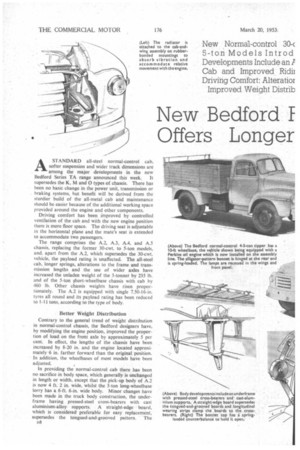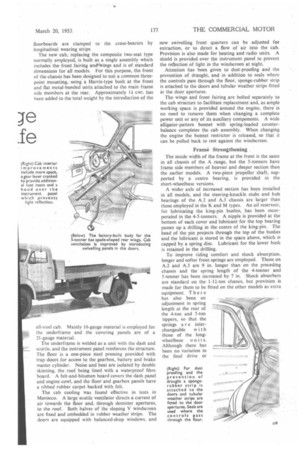New Bedford f Offers Longer
Page 54

Page 55

Page 56

If you've noticed an error in this article please click here to report it so we can fix it.
ASTAN DAR D all-steel normal-control cab, softer suspension and wider track dimensions are among the major developments in the new Bedford Series TA range announced this week. It supersedes the K. M. and 0 types of chassis. There has been no basic change in the power unit, transmission or braking systems, but benefit will be derived from the sturdier build of the all-metal cab and maintenance should be easier because of the additional working space provided around the engine and other components.
Driving comfort has been improved by controlled ventilation of the cab and with the new engine position there is more floor space. The driving seat is adjustable in the horizontal plane and the mate's seat is extended to accommodate two passengers.
The range comprises the A.2, A.3, A.4, and A.5 chassis, replacing the former 30-cwt. to 5-ton models, and, apart from the A.2, which supersedes the 30-cwt. vehicle, the payload rating is unaffected. The all-steel cab, longer springs, alterations to the frame and transmission lengths and the use Af wider axles have increased the unladen weight of the 3-tonner by 235 lb. and of the 5-ton ;hort-wheelbase chassis with cab by 460 lb. Other chassis weights have risen proportionately. The A.2 is equipped with single 7.50-16-in. tyres all round and its payload rating has been reduced to 1-1} tons, according to the type of body.
Better Weight Distribution Contrary to the general trend of weight distribution in normal-control chassis, the Bedford designers have, by modifying the engine position, improved the proportion of load on the front axle by approximately 5 per cent. In effect, the lengths of the chassis have been increased by 8-20 in. and the engine located approxirnately •6 in. farther forward than the original position. In addition, the wheelbases of most models have been adjusted.
In providing the normal-control cab there has been no sacrifice in body space, which generally is unchanged in length or width, except that the pick-up body of A.2 is now 4 ft. 2 in. wide, whilst the 3-ton long-wheelbase lorry has a 6-ft. 6-in, wide body. Minor changes have been made in the truck body construction, the underframe having pressed-steel cross-bearers with cast aluminium-alloy supports. A straight-edge board, which is considered preferable for easy replacement. supersedes the tongued-and-grooved pattern. The
08 floorboards are clamped to the cross-bearers by longitudinal wearing strips
The new cab, replacing the composite two-seat type normally employed, is built as a single assembly which includes the front fairing ancrwings and is of standard dimensions for all models. For this purpose, the front of the chassis has been designed to suit a common threepoint mounting, using a Harris-type bush at the front and flat metal-bonded units attached to the main frame side members at the rear. Approximately 11 cwt. has been added to the total weight by the introduction of the
all-steel cab. Mainly 16-gauge material is employed for the underframe and the covering panels are of a 21-gauge material.
The underframe is welded as a unit with the dash and scuttle, and the instrument panel reinforces the structure. The floor is a one-piece steel pressing provided with trap doors for access to the gearbox, battery and brake master cylinder. Noise and heat are isolated by double skinning, the roof being lined with a waterproof fibre board. A felt-and-bitumen board covers the dash panel and engine cowl, and the floor and gearbox panels have a ribbed rubber carpet backed with felt.
The cab cooling was found effective in tests in Morocco. A large scuttle ventilator directs a current of air towards the floor and, through demister apertures, to the roof. Both halves of the sloping V windscreen are fixed and embedded in rubber weather' strips. The doors are equipped with balanced-drop windows, and new swivelling front quarters can be adjusted for extraction, or to direct a flow of air into the cab. Provision is also made for heating and radio units. A shield is provided over the instrument panel to prevent the reflection of light in the windscreen at night.
Attention has been given to dust-proofing and the prevention of draught, and in addition to seals where the controls pass through the floor, sponge-rubber strip is attached to the doors and tubular weather strips fitted at the door apertures.
The wings and front fairing are bolted separately to the cab structure to facilitate replacement and, as ample working space is provided around the engine, there is no need to remove them when changing a complete power unit or any of its auxiliary components. A wide alligator-pattern bonnet with spring-loaded counterbalance completes the cab assembly. When changing the engine the bonnet restrictor is released, so that it can be pulled back to rest against the windscreen.
Frame Strengthening The inside width of the frame at the front is the same in all chassis of the A range, but the 5-tonners have frame side members of heavier and deeper section than the earlier models. A two-piece propeller shaft, supported by a centre bearing, is provided in the short-wheelbase versions.
A wider, axle of increased section has been installed in all models, and the steering-knuckle stubs and hub bearings of the A.2 and A.3 chassis are larger than those employed in the K and M types. An oil reservoir, for lubricating the king-pin bushes, has been incorporated in the 4-5-tonners. A nipple is provided at the bottom of each cover and lubricant for the top bearing passes up a drilling in the centre of the king-pin. The head of the pin projects through the top of the bushes and the lubricant is stored in the space above, which is capped by a spring disc. Lubricant for the lower bush is retained in the drilling.
To improve riding comfort and shock absorption, longer and softer front springs are employed. Those on A.2 and A.3 are 9 in. longer than on the preceding chassis and the spring length of the 4-tonner and 5-tonner has been increased by 7 in. Shock absorbers are standard on the l-1-ton chassis, but provision is made for them to be fitted on the other models as extra equipment. There has also been an adjustment in spring length at the rear of the 4-ton and 5-ton tippers, so that the springs a r e interchangeable with those of the long
wheelbase unit S. Although there has been no variation in the final drive or braking systems of the rear axles, the length of the tubes of the main case has been altered on the A.2 and A.3 chassis to accommodate the wider track.
• The six-cyfindered 3.52-litre petrol engine is again common to the range, but the Perkins P.6 oil engine will be optional in the 4-ton and 5-ton chassis. Arrangements have been made for the oil engine to be installed on the Bedford production line, whereas formerly it has been offered as a replacement unit. Where the oil engine is fitted, the 10-in, clutch is replaced by a 12-in. unit, which requires a change in the main-drive pinion and gearbox front cover. A cranked gear lever is used on all models to provide more foot space in the cab.
20-gallon Fuel Tank Other chassis alterations comprise a 20-gallon fuel tank on the 4-tonners and 5-tanners, an improved version of the 0-type worm and sector steering for all models, and increased-capacity radiator. This radiator is attached to the cab-and-wing assembly on rubberbonded mountings to absorb vibration and accommodate movement between the top and bottom tanks and the engine. The lighting system has been modernized with the introduction of pre-focused flush-fitting head lamps and recessed side lamps. The twin tail and stop lamps and the instrument panel are also common to the Bedford 7-ton range. The wheel and tyre equipment is in accordance with wide-base-rim practice.
The all-metal pick-up body of the 1-1i-tanner is of the type used in the oilfields and is devoid of internal wheel-arches. It has a 9.-ft. I1-in, wheelbase, which is common to the 3-ton tipper chassis. The 3-ton truck has an 11-ft. 11-in, wheelbase and a standard body equipped at the rear with new spade-shaped wings. The 4-5-tonners are available in 10-ft. and 13-ft. 11-in,
wheelbases, the former being for tipper and semi-tractor purposes and the longer versions are for use with factory-built drop-sided truck bodies. All models are available as chassis or with cabs.
Spenborough Engineering Co., Heckmondwike, Yorks, will continue to make hand tipping gear (model 118.28) and bodywork for the 3-ton short-wheelbase chassis. Spenborough ET.42 hand hydraulic gear and EP.42 power hydraulic gear are also available for the 3-tanner.










































































































